As of midnight last night, part of the FAA shut down due to fun politics. Part of the shutdown was not having the ability to renew FAA taxes on airline ticket sales. Some airlines are taking advantage of this and offering lower fares, others are using this as a chance to earn a little extra dough.
It makes sense for airlines to go both directions. One is really just your classic sale promotion and using the timing of the taxes. For the others, I would assume that most consumers do not understand that there are no taxes and are not aware that even though the taxes are removed, most airlines have just raised fares to compensate.
UPDATE 1: I have confirmed that Spirit Airlines is passing the savings on to customers. I have heard rumors that Frontier is as well, but waiting to confirm.
UPDATE 2: Hawaiian Airlines is also sharing the love with customers.
UPDATE 3 (7/24 2pm PDT): Frontier Airlines is also sharing the love. American and JetBlue have raised their fares.
UPDATE 4 (7/25 7:45am PDT): It looks like some airlines might have had a change of heart. Working to confirm, but appears that Virgin America and Frontier might have stopped passing on their savings and have raised fares. For now I am changing Virgin America and Frontier to “unknown.” Also checking in with Alaska, Spirit and Hawaiian to see their thoughts.
UPDATE 5 (7/25 8:55am PDT): Spirit Airlines has confirmed they are still offering lower fares. Virgin America has raised some of their fares, but not all of them.

Currently, only a few airlines are passing the FAA tax savings to customers.
I am trying to talk directly to US airlines through out the day and will be updating. I am hearing somethings from reliable sources, others are more like rumors and I am being sure to indicate each:
ALASKA AIRLINES- Sharing the Love
Alaska Airlines is advertising on their main page that they are having cheaper prices due to no FAA taxes. A spokesperson with Alaska explained via email, “We’re not raising fares. We’ll continue to pass the savings on to customers.”
SPIRIT AIRLINES- Sharing the Love
I have confirmed directly with Spirit that they are passing down the savings and have no plans to stop.
As of 6:30pm PST on 7/24 there is no information about their “Spirit Airlines is Giving Customers Their Share of $200 Million Per Week in Tax Savings!” deal on their webpage, but an email was sent out to their VIP customers (thanks John B for sharing). In the email they state, “Spirit has become a model for transparency, ensuring customers are not impacted by hidden fees as practiced by other airlines and the government.”
HAWAIIAN AIRLINES- Sharing the Love
Hawaiian Airlines is promoting saving money via the FAA Taxes on Twitter: “Some major federal taxes on airline tickets have taken the weekend off. BOOK NOW.”
VIRGIN AMERICA- Sharing Some of the Love
Over the weekend, Virgin America ran a special “Evade Taxes. Take Flight,” campaign, but now the website is changed. As of 10:40pm last night they were advertising fares with lower federal taxes. As of Monday morning, they have raised some of their fares. “Yes, we were automatically passing on the equivalent discount (down to the decimal) across the board through the weekend ’“ and encouraging guests to grab the discount early,” Abby Lunardini with Virgin America Communications explained over email. But, given the dynamic nature of fares, with the Monday morning fare load ’“ some fares have changed and/or moved up, but some of the discounts have held.”
FRONTIER AIRLINES- Unknown
As of Monday morning I am hearing rumors that Frontier has raised their prices. Emails, calls and messages sent via Twitter have not yet been returned to confirm.
DELTA AIR LINES- Keeping the Money
It seemed earlier in the day that Delta was going to share the love, but it has been decided to raise fares.
SOUTHWEST AND AIRTRAN- Keeping the Money
“Southwest and AirTran implemented a system wide fare increase of $4 each-way to help offset industry cost pressures ’“ such as the rising expense of fuel,” Brad Hawkins with Southwest Communications explained over email. “Our current ticket prices will remain the same (Customers will not see an increase in fares), as the 7.5% excise tax will not be collected. These decisions were made in light of the recent industry change in aviation tax collections, and we made a business decisions to remain competitive in these economically challenging times.”
UNITED AIRLINES- Keeping the Money
United has decided to match the taxes and have increased fares.
AMERICAN AIRLINES- Keeping the Money
According to the LA Times, American Airlines and JetBlue have raised their fares and are keeping the extra FAA tax money. “So in effect the taxes are not being collected, but the price paid by the customer remains the same,” American’s Tim Smith told the LA Times.
JETBLUE- Keeping the Money
JetBlue has decided to raise fairs and a spokesperson told AirlineReporter.com, “We’re working with the Federal Government to determine how the recent expiration of the Federal Excise Tax, and other taxes, will impact our operation. We have participated in an industry-wide fare increase in order to remain competitive.”

Three years is a long time, but I can keep on going.
Three years ago today I made my first (and totally amazing) post — a lot has changed since then. It has been an unbelievable three years, but not without its challenges. Over the past three years I have also worked a “real” job and juggled personal life, work and the blog — but it has been worth it.
I have felt privileged to have been given so many rad opportunities and the ability to share them with you fine folks.
To celebrate the birthday of the blog, I want to SEND YOU FREE STICKERS. All you need to do is email me your mailing address to da***@*************er.com (do not worry, won’t do anything with you address, but mail stickers) and I will sending you some AirlineReporter.com stickers as a thank you for reading the blog.
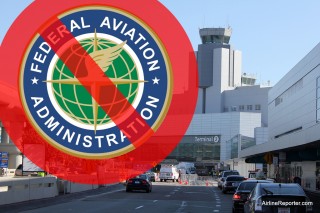
The FAA gets dissed.
Since politicians were not able to come to an agreement over extending the operating authority of the FAA as of midnight tonight, about 4,000 people will be out of work and federal airline ticket tax will no longer be collected. The shutdown will not affect airline safety, but it will stop airlines from collecting about $200million per week in ticket taxes that would help to to fund FAA programs. In the short term, passengers might celebrate since they will be able to save money by not paying taxes, but this means that projects will be delayed and costs might end up being higher in the long run.
At this time it seems unclear exactly how this partial shutdown will affect the airline industry. Although confusing, I am willing to bet that Spirit Airlines will come up with some fancy advertising campaign about the FAA shutdown. Although I normally celebrate an airline’s unique advertising campaign, it seems odd to celebrate a failure in politics, which will end up hurting airline-related projects, but I am sure it will happen.
Update 1: looks like Virgin America jumped on the tax-themed sale already.
Update 2: Boeing confirmed via email to AirlineReporter.com that 787 Dreamliner and 747-8 certifications will not be affected by the FAA partial shut down.
Update 3: Alaska Airlines is also advertising (see screen shot) lower fares from the FAA partial shut down on their homepage. Still nothing from Spirit Airlines — guess I was way off on that one.
Here is the direct copy and paste of the FAA’s press release as well as some information from Alaska Airlines how these changes will change their fares…
From the official FAA Press release:
Transportation Secretary Ray LaHood and FAA Administrator Randy Babbitt expressed disappointment today after Congress adjourned for the week without passing a clean FAA reauthorization extension. Because of Congress’ inaction, many states will have to bear a significant economic burden and many airport projects will be halted.
’œI’m very disappointed that Congress adjourned today without passing a clean extension of the FAA bill,’ said Secretary LaHood. ’œBecause of their inaction, states and airports won’t be able to work on their construction projects, and too many people will have to go without a paycheck. This is no way to run the best aviation system in the world.’
The current FAA reauthorization expires at midnight tonight, Friday, July 22, 2011. Congress has extended the FAA’s authorization 20 separate times without controversy. Without an extension, the FAA will be forced to furlough nearly 4,000 employees and will be unable to move forward on important airport construction projects and other critical airport activities.
While this lapse in FAA’s authorization affects thousands of public and private sector jobs, it is important to note that the safety of the flying public will not be compromised.
’œThe FAA employees who will be furloughed perform critical work for our nation’s aviation system and our economy,’ said FAA Administrator Babbitt. ’œThese are real people with families who do not deserve to be put out of work during these tough economic times.’
The Airport Improvement Program has already stopped processing new airport grants in anticipation of a furlough. The program, which provides construction project grants to airports, will be shut down and unable to provide roughly $2.5 billion for airport projects in all 50 states that could put thousands of people to work in good paying jobs.
For example:
* Orlando International Airport in Orlando, Florida is still waiting on funding to rehabilitate a major taxiway
* St. Petersburg-Clearwater International Airport in St. Petersburg-Clearwater, Florida is still waiting on funding to rehabilitate Runway 04/22
* Cambridge Municipal Airport in Cambridge, Ohio is still waiting on funding to acquire snow removal equipment and conduct a survey to develop an instrument approach procedure
* Houghton County Memorial Airport in Hancock, Michigan is still waiting on funding to modify their terminal building and discourage wildlife from entering the active airfield
* Richmond International Airport in Richmond, Virginia is still waiting on funding to proceed with construction of a new apron for terminal concourse A
* Henderson City-County Airport in Henderson, Kentucky is still waiting on funding to rehabilitate Runway 09/27
* Clovis Municipal Airport in Clovis, New Mexico is still waiting on funding to relocate the localizer equipment due to a runway extension construction. This equipment is out of service on the main runway until the project can proceed
* Lubbock International Airport in Lubbock, Texas is still waiting on funding to begin the third phase of a critical runway rehabilitation
* Adams Field in Little Rock, Arkansas is still waiting on funding to begin the rehabilitation of taxiway lighting, construction of a Runway Safety Area, and the installation of Precision Approach Path Indicator
Additionally, the FAA will be forced to withhold money for states and individual airports as a result of the lapse in authorization. For example, Florida airports will not have access to over $40 million in funding and the state of California cannot use nearly $38 million. The FAA also cannot give the state of Ohio over $10 million in airport grant money or the state of Virginia over $16 million for which they are eligible.
Up to 4,000 FAA employees in 35 states, the District of Columbia and Puerto Rico will be furloughed and forced to go without pay. Large numbers of employees in New Jersey, New York, California, Georgia, Oklahoma, Texas, Washington, Illinois and the District of Columbia will be affected. This includes many of FAA’s engineers, scientists, research analysts, administrative assistants, computer specialists, program managers and analysts, environmental protection specialists, and community planners.
Specific Details from Alaska Airlines:
For tickets sold on alaskaair.com starting 12 a.m., Saturday, July 23, 2011, the following taxes will not be collected until congress votes to reinstate them:
* The 7.5% tax generally applicable to domestic transportation (as well the7.5% tax on amounts received from the sale of ’œfrequent flier miles’.)
* The $3.70 domestic segment tax.
* The $16.30 international arrival/departure tax.
* The $8.20 departure tax for flights between Alaska/Hawaii and the mainland US.
For example, on Alaska this represents a savings of approximately $44 off a $300 roundtrip ticket, or about 14 percent. All other taxes and fees will continue to apply.
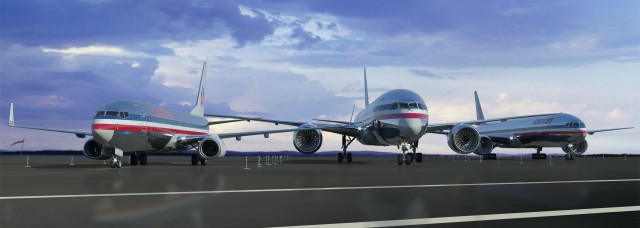
Computer generated image of an American Airlines Boeing 737, 787 Dreamliner and 777. It is fun to see the 787 in metallic finish, but the composite body would not make that possible. Image via Boeing.
I spent a nice chunk yesterday evening trying to get through all the recent information on American Airline’s record breaking order of aircraft. My first big question is why would an airline that lost $286million during 2nd quarter 2011, look to spend so much money on new aircraft? Airlines that lose money is not a new concept, but at a time when most airlines are raking in profits, American is still stuck in the red. The airline obviously needs to do something drastic and they are hoping that updating their fleet will achieve their goal. It seems like this is the correct direction, but there is much more than new planes needed to survive.
In case you missed it, American Airlines announced the purchase of 460 new aircraft, which is the largest single order in history. This will include 260 Airbus and 200 Boeing aircraft. I assume that the folks at American have run the numbers and found that with the expected cost of fuel and maintenance of older aircraft, it makes more sense, long term, to operate newer aircraft. It is likely that American had a huge advantage working Boeing and Airbus against each other to achieve the best pricing and they have beat Delta Air Lines and United Airlines to the punch of updating their fleet. In fact, American expects to have the newest fleet of all major US carriers in just five years, which is an impressive feat knowing that their average age of aircraft today is about 15 years.
According to Boeing’s press release, American was offered a 737 re-engine option that has not yet been approved by the board of directors. “In addition, American Airlines has committed to order a variant of the 737 featuring new more fuel-efficient engines, pending final airplane configuration and launch approval of the program by the Boeing board of directors.”
If approved, American wouldn’t be the only one interested in a re-engined Boeing 737. Flight Global quoted, Bill Ayer, CEO of Alaska parent Alaska Air Group, during an earnings call yesterday as saying, “We are very much in favor of lower fuel burn, and if Boeing can do this sooner rather than later, that’s a good a thing.” Alaska Airlines operates a fleet of only Boeing 737s.
Southwest Airlines is another all-Boeing airline based in the US and Brad Hawkins with corporate communications told AirlineReporter.com, “We, of course, have frequent dialogue with our partners, including Boeing, but we don’t disclose the details of those conversations unless we have an update to share.” I think it would be obvious that Southwest would like a plane with better efficiency to start replacing their large fleet of older 737-300s and 737-500s.

Computer rendering of an Airbus A320 in American Airlines livery. Notice the flat gray paint. Image via Airbus.
It seems the bottom line here is survival. American knows that gas isn’t going to get any cheaper and continuing to operate fuel inefficient aircraft is not going to be sustainable. However, survival is going to take more than just new aircraft.
One of the first things I thought of with such a large order is, “livery change.” When I posted how I wasn’t a huge fan of the current American Airlines livery, I got a lot of backlash. It seems that either folks love the current livery or feel it is aged and time to go. If American is looking to modernize their fleet and move into the future, I think they need a livery to match.
Yes, it is unique design, but it just looks aged. Then add the fact that the Boeing 787 Dreamliner (which American has 42 on order) won’t work with American’s bare fuselage livery due to the composite material and you have a great opportunity to change livery. I think painting the aircraft with a metallic silver base paint with updated, swooping, red, white, and blue lines could look slick. Then add a single color AA Eagle to the tail and you have yourself one nice looking livery — with ties to the past. Going with a flat gray paint scheme was done with the Airbus A300 and it looks better than the patchy A300 with bare metal, but still not a modern looking scheme. When I asked American about the possibility of a new livery they stated that, “Those decisions have not been made yet. That said, we do have to determine how to paint the 787. Obviously, we have to determine and make that decision well before the actual delivery in 2014 since painting is part of the manufacturing process.”
With the retro-fitting of new interiors, the addition of the Boeing Sky Interior on their new Boeing 737-800s and new aircraft on order, American Airlines appears to be making a genuine effort. They have also been working to improve their interaction with customers via Facebook and Twitter, which helps them connect with the younger (and more hip older) passengers. They still need to tackle their problems with having a lot of debt, not making a profit and labor cost disadvantage.
After the order was announced, there has been a lot of criticism of American not buying all US built Boeing aircraft — accusing the airline of being un-American. That seems a bit mis-informed since we live in a global economy and trying to make the best deal to earn the most money possible sounds pretty darn American to me. United and Delta, who are the world’s two largest airlines, both operate both Boeing and Airbus aircraft. Not to mention that Air France (Airbus is headquartered in France) operates a fleet of over 80 Boeing (including cargo) airliners.
Be sure to also read:
* Jon Ostrower, on his blog Flight Blogger, posted an informative story on all the numbers relating to this deal and some are a bit surprising.
* Brett Snyder, on CrankyFlier, takes a detailed look how these new aircraft will more than replace the aging MD-80, Boeing 757 and Boeing 767-200 in American’s fleet. He theorizes that American might be looking to replace some smaller aircraft currently flying with American Eagle with larger Airbus A319 and Boeing 737-700 planes.
Singapore Airlines gave a special tour to invited media guests to their training facility located in Singapore and I felt privileged to be among the group. We were able to experience the flight attendant safety training, cabin crew procedure training and the flight simulators.
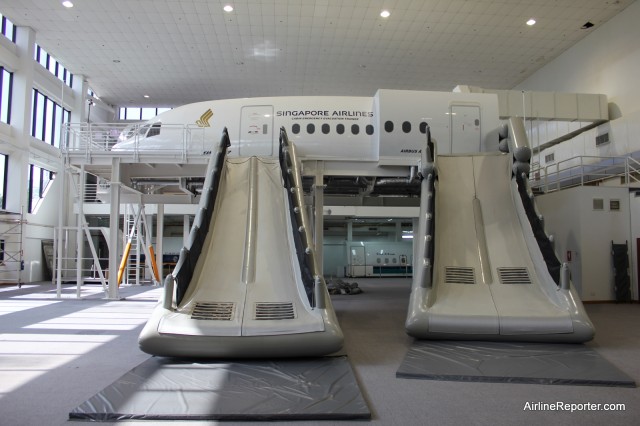
The slides are not for fun. This hybrid of Boeing 777 and Airbus A380 is to teach cabin crew how to evacuate an airplane.
We first entered a large room that looked almost like a play ground with slides, but it was all business. This is where cabin crew learn and get re-trained on safety protocols. There were a number of different interior mock ups and the most interesting was the hybrid slide trainer. This was a unique set up with a Boeing 777 in the front and an Airbus A380 in the rear. The aircraft is used to allow flight attendants to practice evacuating passengers and jumping down the slides themselves. Inside the mock up, the interior was made up of earth-toned seats, with half of it being wider than the other half. The emergency doors had LCD screens located in the windows to simulate what might be on the other side (ie fire, debris) and the flight crew must react accordingly. Other mock ups in the facility allow cabin crew to practice opening emergency doors, escape from crew quarters and learn the proper operations on different aircraft.
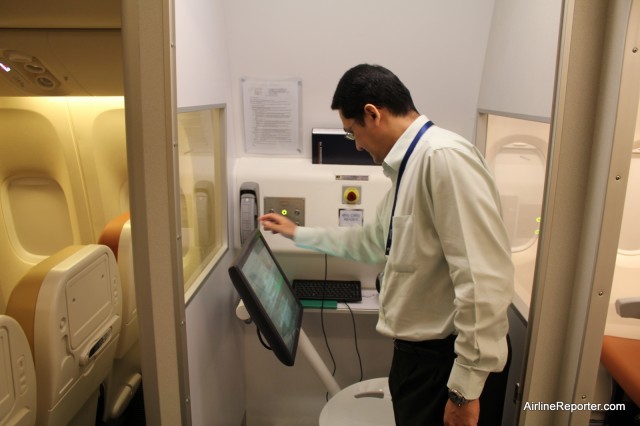
Instructors are able to set up a number of different scenarios for flight attendant training.
The larger hybrid airline cabin is able to be filled with smoke to simulate an emergency situation (see an example from when I visited AirTran). There is a control panel that lets the instructor set up a scenario and the flight attendants must react accordingly. I was hoping to have an opportunity to take a slide down, but decided on the stairs instead.
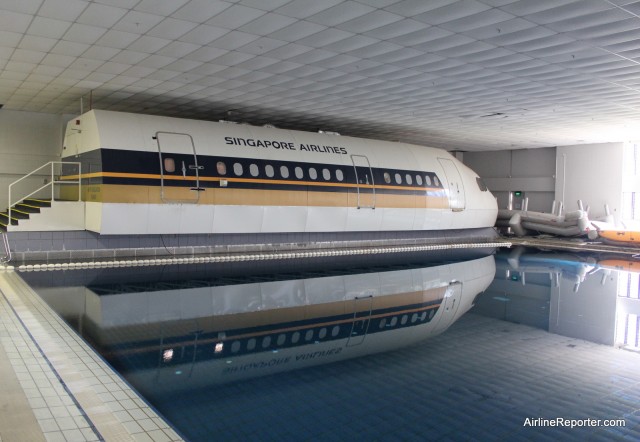
The water is calm in this photo, but during training, instructors can make waves in the Singapore Airlines training pool.
After coming down the stairs, we went into the pool training facility, where flight crew are required to practice jumping into the water with their uniforms. The pool is able to simulate waves and rough conditions, providing an additional challenge for the new trainees. Much like the slide trainer, the interior has a full cabin set up, giving as much realism as possible to an actual water landing event.
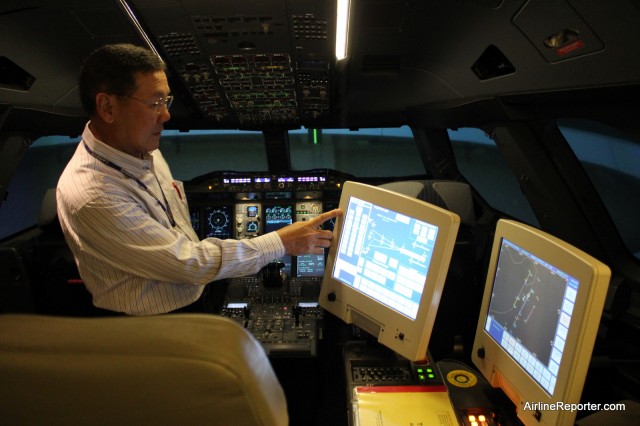
Singapore Airline's Airbus A380 flight simulator has a Star Trek like command chair for the instructor to create almost any scenario possible.
The training facility also operates seven aircraft simulators that cost between $12million and $30million. Singapore Airlines leases time on the simulators for other airlines as well, except the Airbus A380 since they need all the time on it as possible. The A380 simulator is unsurprisingly big and although it is a massive beast — she flies like a champ. The simulators have full motion giving pilots realistic g-forces during landing, take off and maneuvers. Instructors are able to sit in a command seat behind the pilot and co-pilot to create dangerous situations at airports around the globe. Before pilots take a spin on the larger simulator, they are able to practice the proper procedures on a much more simplistic (and cheaper) Flight Training Device.
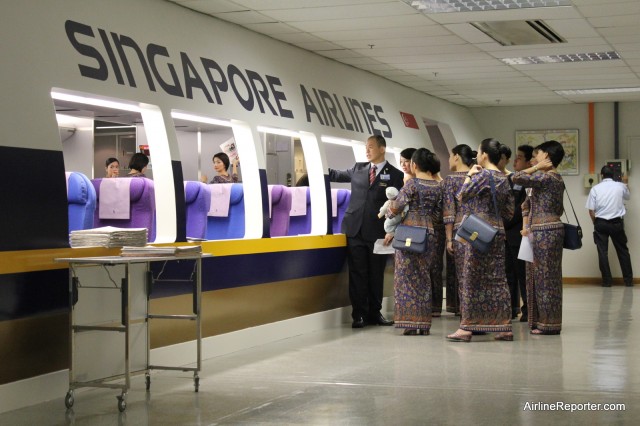
New Singapore Girls learn how to work the economy section at the training facility.
Even though safety is the most important aspect of a flight attendants job, a large portion of the facility is set up to teach flight attendants how to take care of their customers. Down a long hallway, there are multiple mock-ups to let new employees learn customer service for economy, business and first class passengers. Interestingly, part of their training includes greeting facility guests with a warm welcome. It is quite impressive to walk by a group of 25+ new flight attendants and have them all welcome you to the training center.
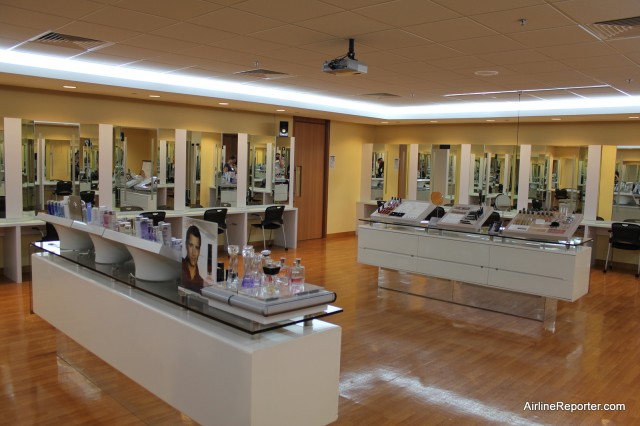
Looks and proper grooming is important to Singapore Airlines. This room, new hires learn how to look professional during long flights in a low-humidity environment.
First impressions are important and Singapore Airlines makes sure their entire flight crew look professional. Even though the male crew won’t be wearing any make-up, they still go through the full training to learn how to keep their skin from getting too dry and how to assist their female co-workers. There is a classroom dedicated to make-up and scents training and another for flight attendants to practice walking properly.
Singapore Airlines is known for their high-end service and it takes quite a bit of work to accomplish. Besides basic training, flight crew are required to return for additional and advanced training. Even though the facility might look like fun and games, everything done there is for either customer service or safety. Both are very important aspects to running a successful airline and it seems to be working quite well for Singapore Airlines.
CHECK OUT ALL 30 PHOTOS OF SINGAPORE AIRLINES TRAINING FACILITY










